|
|
Laser
F/X On-line Newsletter - Special Reports


Monday,
May 31 1999
Seminar Day
Breakfast
was the first thing on the agenda and everyone had a chance to talk about
the demonstration of the new Cambridge galvos at the Brewster Awards. The
first event of the day was the "What's New" Seminar.
Seminar 1
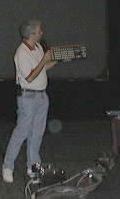 |
Pangolin Laser
Systems was first up. Patrick Murphy showed and described four new
items:
- Lasershow Performer, the
lighted console which works with the new Live! Software from
Pangolin to give real-time selection of pre-programmed effects
as well as control of such parameters as zoom and brightness.
- The C10 geometric and
colour correction box. It has the common geometric corrections,
plus individual colour corrections for each PCAOM channel. In
addition, it has window masking so you can set areas for
audience scanning where the beam intensity can be reduced or
eliminated. The C10 is made by Laser System Europe and Pangolin
is the North and South American distributor.
|
- The next-generation Lasershow
Designer board. This successor to the QuadMod fits in a PCI slot, and
allows much higher scanning speeds and more software features than the
current QuadMod. Patrick indicated the beta test units would be sent out
in a few months, with end-user shipments before the ILDA meeting in
November.
- Special tuning and component
adjustments to standard Cambridge 6800 scanner systems, which let them
run at a true ILDA 50K speed (circle remains touching the square at
50,000 PPS, at a scan angle of 7 degrees). The Pangolin modification was
demonstrated at length so the conference attendees could have no doubt
that the scanners met specifications.
Dirk Bauer of
MediaLas in Germany then presented the ILDA award-winning 30K
Catweazle LC scanners and the CatSafe scan fail detection board.
- The 30K Catweazle LC
scanners faithfully reproduce the ILDA test pattern at 30K and
will soon be available with mirrors to handle laser powers up to
5 watts.
- The CatSafe board
continuously monitors the input signal and the position of the
scanners and compares them to detect a scanner failure. In the
event of a scan failure, the board kills the output to the PCAOM
preventing an unscanned beam from being projected.
|
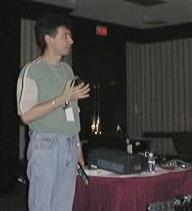 |
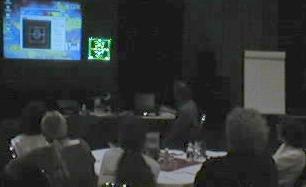 |
New Method Lasers then
presented the new Cambridge 6210 scanners using one of their Micro
YAG lasers.
- Bob Ash showed a special
program called the "Cambridge Torture Rack" which is
capable of outputting points at speeds up to 100K. While the
images displayed were very sharp and flicker free, the ILDA Test
Pattern could only be displayed at about 48K before the circle
began to pull away form the inside of the square [see Scanner
Wars page for
more details].
|
Rick Gephardt from Laser Illusions
gave a brief outline of the new X-29 Turbo board.
- This is a half-length ISA card
is designed to be placed in a slot adjacent to the output board for the
X-29 and Full-Auto software. Using cables supplied by Laser Illusions,
the outputs from the NML interface card are connected to the Turbo
board. The board buffers and decodes all of the colour control signals
and presents them as a fully compliant, balanced line signal on the ILDA
standard DB25 connector. An additional DB9 connector outputs eight opto-isolated,
level shifted signals provided by the interface board for beam table
control.
Richard
Gonsalves (on left in photo) of RAGe Media showed the beta version
of his new image converter software.
- This package due for
release later this summer converts a variety of popular computer
graphics files such as CAD and bitmap files to ILDA frames. The
program also converts text typed into a box to a laser version
of any TrueType font resident on your system and can import
plain .txt files for conversion.
No additional hardware is required for the converter which can
run on any computer making it ideal for use in the studio for
graphics conversion without tying up your laser system.
|
 |
Seminar 2
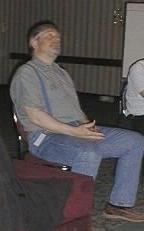
Jan Kriland
|
The second
seminar was the Creative Seminar featuring Jan Kriland of AB Obscura
Magica Productions in Sweden. Jan gave a spellbinding presentation
with images of some of his work shown form computer. He covered some
of his most interesting and artistic works and also talked about how
sound was a big influence in his show and how he might work for up
to three weeks to get just the right sound for his presentation. He
also gave as an interesting inside look at his "Job Opera"
show in Germany. This show involved projecting stereoscopic images
60 meters long by 40 meters high onto a special screen on the
opposite side of a river from the grounds of the opera house where
the audience was located.
Starting with photos of himself and his crew struggling through
muddy farmers fields to erect a test screen for the proof testing of
the concept to images from the final production.
Many technical problems had to be
overcome including locating the right type of polarisation-preserving paint
for the stereoscopic 3D images, The tremendous throw distance involved also
had to be tested to insure that the audience would see the images in 3D with
the glasses distributed at the event. The final show included a mammoth
multi-channel sound system (flown from cranes on the riverbank), live
musicians, singers and beam effects lasers as well as the huge stereoscopic
3D images. |
Jan also gave us a preview of his
upcoming project the "Water Festival". For nine nights the centre
of Stockholm will be the site of large (60 X 40 meter) stereoscopic 3D laser
projections, beam effects lasers, smoke effects and other special effects
for an estimated audience of 50,000 people per night.
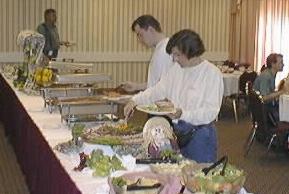
Seminar
3 - A & B
After lunch, laserists
broke into two groups for the afternoon seminars. The first was the Scanning
Systems seminar where Dirk went into more details on his 30K scanners and
the CatSafe scan fail detection board. The simple-to-implement CatSafe board
works with Catweazle scanners or CTI 6800 scanners and continuously monitors
the position of the galvos using an on-board computer. In the event that
either of the scanners should fail to respond, the board extinguishes the
colour control signals to the PCAOM to prevent an unscanned beam from being
projected.
| Martina Casey
and Giovanni Aquino of Cambridge Technology then presented the new
6210 galvos. They said these galvos are smaller and lighter weight
than the 6800HP scanners and should be significantly faster. They
were demonstrated doing 48K on the ILDA Test Pattern, but the
expectation is that with a bit more work, they will soon reach 60K. |
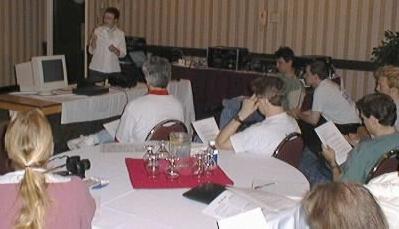 |
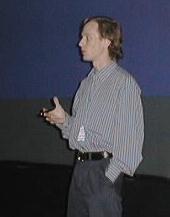 |
In the parallel seminar, Ian
Wood, a recent Sheraton College multi-media graduate, presented tips
and techniques for marketing using videos and web pages. Ian started
by showing the Star Wars Episode 1 trailer and then doing an
analysis of how the video was put together with shots and sequences
of various lengths to draw the viewer's attention and promote the
movie. He also showed other video clips from companies marketing
high-tech products to demonstrate how they showed the product in
action and how they made use of "talking head' segments.
Next Ian presented some tips for web page design and navigation,
showing both good and bad examples of various websites. He then
moved on to some of the newer techniques such as Shockwave that are
being used to enhance web sites and deliver the marketing message. |
The afternoon break featured milk,
chocolate milk, and a variety of freshly baked cookies. The milk and cookies
break was sponsored by FirstLight Laser Productions.
Seminar 4 - A & B
| After the afternoon break,
two parallel seminars were again offered. The first was an airspace
and safety update featuring James H. Maurstad of Transport Canada
and Patrick Murphy, ILDA Airspace Issues Coordinator. James is one
of the government officials responsible for creating and
implementing regulations for the use of lasers in outdoor shows
where they may present a hazard to aircraft. This was a unique
opportunity for laserists to hear directly from a government
regulator who is tasked with keeping the sky safe for aviation and
who also wants to keep the laserists on the ground in business. |
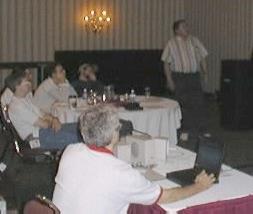 |
The other parallel seminar was the
second half of the Marketing Workshop with L. Michael Roberts covering ways
of finding shows and keeping customers happy. Michael discussed the regular
means of promotion such as targeted mailing and cold calling. Also presented
were ways to use the Internet such as looking for city and regional sites
that promote special events, or "lurking" in regional and city
USEnet groups to monitor announcements of special events and then contacting
the organisers to pitch one's services.
LaserFest
After some free time, laserists
again convened in the Halton A & B Halls for the LaserFest. An excellent
buffet dinner was complemented by a wine service from Pangolin Laser
Systems.
|
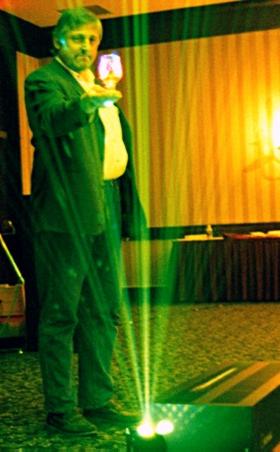
Photo by Frank Plughoff
|
After the
dinner, our guest laserist, Jan Kriland, showed a selection of his
works with commentary on the creative aspects of the shows.
Born in Stockholm, Sweden, in 1951 the son of one of Sweden´s
foremost surrealist painters and drawers, Jan Kriland has, since the
early 1980's, used laser technology for various visual
presentations, ranging from commercial shows to cultural
performances. His main aim is to develop and produce artistic laser
performances for cultural purposes, to ensure the beholder a full
multimedia experience for all senses.
In 1987, the Kalmar Museum of Art in Kalmar, Sweden, planned an
exhibition named "Magic Light", devoted to the role and
concept of light in art. Kriland was asked to participate and
accepted immediately. The exhibition, and especially Kriland´s
experimental performances, turned out to be a splendid success which
moved one art critic to write that "the queues to Kriland´s
appearances are longer than those at the State liquor shop right
before closing time on a Friday afternoon"....
Shortly thereafter, Kriland was contacted by Swedish composer Jan W.
Morthensen who proposed a collaboration over a musical piece he was
composing.
The result was the widely acclaimed
Silence XX (1988), an ascetically stern electro-acoustic work accompanied by
an almost mathematically disciplined use of the laser. "Silence really
was the beginning of it all" Kriland remembers. "The collaboration
with Morthensen opened my eyes to the marvellous and exciting possibilities
of the use of laser in art. A new, unexplored territory lay before me."
Silence XX had its premiere at the Electro-Acoustic Music Festival at
Skinnskatteberg, Sweden, in 1988, and has since then been performed at the
Royal Academy of Music in Stockholm; at the Berlin Congress Hall as an event
forming part of the Berlin -- Cultural Capital of Europe Year 1989; and led
to an invitation to take part in the Computer Music Concert ´92 in Seoul,
South Korea. |
After Jan's presentation of his
always interesting and artistic work, a variety of laser modules were played
back from ADAT for the enjoyment of all.
- The first module was created to
the theme music from Armageddon by the 6th
grade music class of John Faith using very basic X/Y systems with no
blanking or colour control.
- Stairway to Heaven from
FirstLight Laser Productions was a favourite with the rock and roll fans
in the audience.
- Monty Python's "Meaning of
Life" from Kyle Garner and Paul Banda at Laseronics Northwest
provided some comedic moments.
- We were treated to a reprise of
the Nike module by AB Obscura Magic. Jan had, in his earlier
presentation, explained that the abstract shapes used in the piece had
been taken from the sole of the runners....
- and a reprise of the Austin
Powers all raster module from New Wave.
- A new condition was added to
enter the Brewster Awards in 1998 when winners agreed to be part of a
compilation tape. The 1998 third place winner "Money" by
FirstLight, second place winner "Sound Is Laser" by Laser
Spectacles and first place "World In Motion" show from
MediaLas were played from the compilation
tape.
A brief break to visit the bar and
stretch the legs was followed by beam module playback.
- First up was second place
Brewster Award-winning graphics module "Sound Is Laser" by Tim
Walsh of Laser Spectacles. This module works well as either a beam or
graphics module and is exceptional when presented as a beam and graphics
module as seen at the ILDA Conference in Amsterdam.
- Third place Brewster winner
"Digital Dreamer" by MediaLas of Germany
- Followed by first place winner
"Nightmare" by Dave Nash of FFP Lasers in Canada.
- A beam module set to the song
"Children" and created by Laser F/X followed.
- Then a reprise of one of this
year's Brewster entries "Laser Trigger" by Tim Walsh of Texas
was played.
- The LaserFest ended with a
playing of the very popular "Carmen" module by LOBO of
Germany.
Everyone attending enjoyed the
conference and remarked on the relaxed pace and the excellent food at the
Holiday Inn.
Links - Quick Links
to Report Pages
In order to present as many pictures as possible, we have broken this
special report down into a number of pages to speed access. Most of these
are large pages with many images so please be patient while they download.
Laser
F/X '99 Report -
Introduction and background
Friday
28 May - Behind
the scenes and the crew
Saturday
29 May - Pangolin
School and Open House
Sunday
30 May - Trade Show
- Trade Show info and pictures
Sunday
30 May - Brewster Awards
- The Banquet and entries
Monday
31 May - Seminars
and LaserFest
Scanner
Wars - Faster than
30K scanners debut at Laser F/X '99
Candid Camera - A selection
of 20 photos (very large page)
DISCLAIMER:
Some of the information in the Backstage area is provided by the
persons or companies named on the relevant page(s). Laser F/X does
NOT endorse or recommend any products/services and is NOT
responsible for the technical accuracy of the information
provided. We provide this information as a service to
laserists using the Backstage area.
[ Introduction
| World Scan | What's New
| Special Reports
| Virtual Visits | General Articles
| Digest ]
|